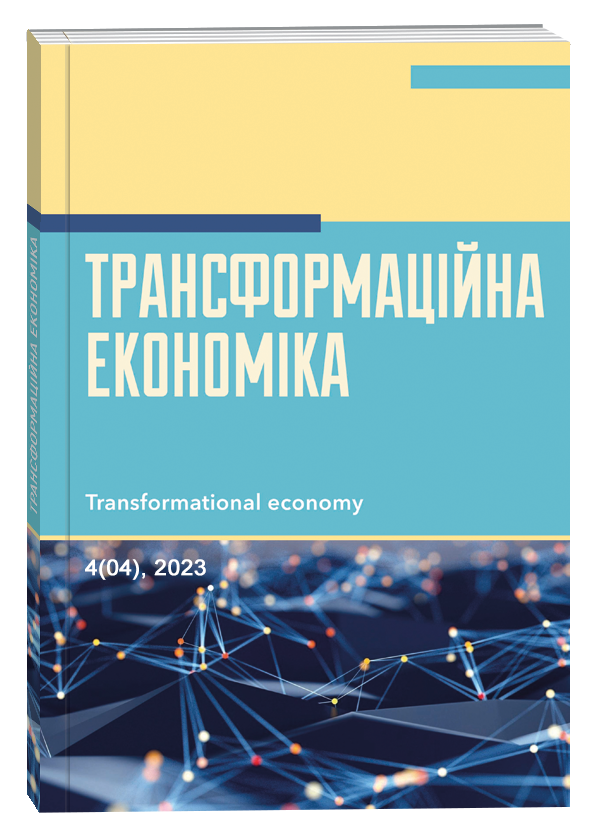FEATURES OF THE WORK ORGANIZATION OF INSURANCE COMPANIES OF UKRAINE DURING THE PERIOD OF ARMED INVASION
Abstract
The article is devoted to the definition of the main aspects of the organization of work of insurance companies of Ukraine during the period of armed invasion. The purpose of the article is to determine the effects on the work of insurance companies in the modern conditions of the armed invasion of Russian aggressors and to provide proposals regarding the priority areas of insurance management. The object of the research is the processes of organization and management of the work of insurance companies. The subject of the study is the ways of optimizing the work of insurers in conditions of external and internal negative influences. The research used general scientific and special research methods: comparative analysis, scientific abstraction and generalization of the scientific experience of modern theoretical studies, a system-complex approach. When conducting an analysis of the dynamics of the number of insurance organizations and gross insurance payments and premiums for the period 2017-2022, it was found that fluctuations in their volumes also occurred in pre-war times. The main reasons that made it possible to effectively reduce the number of insurance service providers without a significant loss of the client base, while simultaneously increasing the guarantee requirements for insurers, were identified. It has been proven that even in the pre-war period, conditions were created for strengthening requirements for corporate governance, introducing a civilized procedure for withdrawing insolvent insurers from the market, and implementing Solvency II. It is noted that Russia's sudden insidious attack caused a wave of violations and disruptions in the work of almost all domestic business entities. revealed that during 2022, the activities of insurance companies and other participants of the financial market of Ukraine took place in the conditions of the maximum limit of destabilization, and the volume of services fell significantly compared to the pre-war period. The structure of assets and liabilities of life insurers and risk insurers in 2022 was studied, and the largest insurance premiums and payments by region of Ukraine as of January 1, 2023 were identified.According to the results of the research conducted by Mrthe development and further development within the framework of state programs and on a unified conceptual basis of the methodology of managing insurance companies in conditions of war, the creation and expansion of a modern intellectual knowledge base of this subject area are recognized as priority areas of insurance management. It was emphasized that measures to ensure the organization of the work of insurance companies during the armed invasion should be based on advanced management techniques using the latest technologies.
References
Akotey J. O., Abor J. Y. (2013) Risk management in the Ghanaian insurance industry Qualitative Research in Financial Markets, no. 5(1). DOI: https://doi.org/10.1108/17554171311308940
Singhal N., Goyal S. & Singhal T. (2022) The relationship between insurance and economic growth in Asian countries: a regional perspective. Macroeconomics and Finance in Emerging Market Economies, no. 15(3), pp. 301–322. DOI: https://doi.org/10.1080/17520843.2021.1957599
Dluhopolskyi O., Khroponiuk D. (2023) Current problems and development prospects of the insurance market of Ukraine. Innovation and Sustainability, no. 1, pp. 118–126. DOI: https://doi.org/10.31649/ins.2023.1.118.126
Poltorak A. (2022) Rozvytok strakhovykh rynkiv yak bazys zabezpechennia rezilientnosti system harantuvannia sotsialno-ekonomichnoi bezpeky rehioniv [The development of insurance markets as a basis for ensuring the resilience of systems guaranteeing social and economic security of regions]. Modern Economics, no. 34, pp. 82–89. DOI: https://doi.org/10.31521/modecon.V34(2022)-12
Chvertko L., Vinnytska O., Korniienko T. (2022) Inclusive orientation of the development of the insurance market of Ukraine in the conditions of digitalization of the economy. Strategii şi politici de management în economia contemporană: conf. şt. intern., ediţia a 7-a, 9-10 iunie 2022. Chişinău: ASEM, pp. 358–364. DOI: https://doi.org/10.53486/icspm2022.56
Pokaznyky diialnosti strakhovykh kompanii. Nahliadova statystyka. [Performance indicators of insurance companies. Supervisory statistics]. Available at: https://bank.gov.ua/ua/statistic/supervision-statist#6
World insurance: inflation risks front and centre (2022) Swiss Re Institute sigma, no. 4/2022. https://www.swissre.com/dam/jcr:4500fe30-7d7b-4bc7-b217-085d7d87a35b/swiss-re-institute-sigma-4-2022.pdf
Bila knyha «Maibutnie rehuliuvannia rynku strakhuvannia v Ukraini» [White paper “Future regulation of the insurance market in Ukraine”]. Available at: https://bank.gov.ua/ua/news/all/bila-kniga-maybutnye-regulyuvannya-rinku-strahuvannya
Insurance TOP #1(93)2023. Available at: https://www.insurancetop.com
Law of Ukraine "On Insurance" dated 11/18/2021 No. 1909-IX. Available at: https://zakon.rada.gov.ua/laws/card/1909-20#Current
On the approval of the Regulation on mandatory criteria and standards of capital adequacy and solvency, liquidity, profitability, asset quality and riskiness of insurer operations. National Financial Service Commission: Regulation of June 7, 2018 No. 850. Available at: https://zakon.rada.gov.ua/go/z0782-18.
About the approval of investment directions of economic sectors at the expense of funds of insurance reserves. Cabinet of Ministers of Ukraine Resolution dated August 17, 2002 No. 1211. Available at: https://zakon.rada.gov.ua/go/1211-2002-%D0%BF


